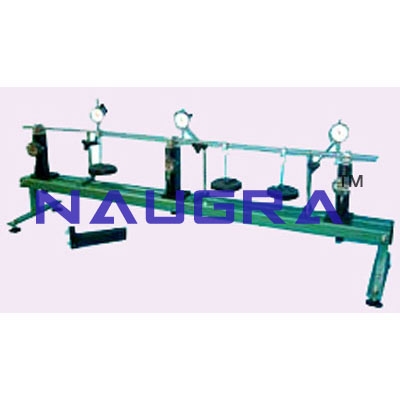- Civil Lab Mechanical Lab Engineering Lab Equipments
- sales@didacticlabequipments.com

CAT NO: DIDACTICNLE-Export-053003
Advanced Beam Testing Apparatus- Engineering Lab Training Systems Ministerial Tender Board Equipment, Ministry of Education and Vocational Training Lab Tenders Suppliers India.
Cost Effective Teaching Comprehensive theory of beams Simple and propped
cantilevers Simply supported, fixed and continuous beams Three piers
measure positive and negative reactions Piers include a re-leveling
system Three dial gauges on stands Point loads and distributed loading
Six test beams to verify all variables Two optional extra sets of
selected beams Data logging option Three year warranty Range of
Experiments All variables in deflection of beams Slope and curvature of
beams Support reactions of single span and continuous beams Effect of
sinking supports Area moment theorems Super-position Clerk Maxwell s
reciprocal theorum Flitched beams Non-uniform beams Description The
apparatus provided allows an unlimited range of beam experiments to be
performed to measure support reactions and the deflections and rotations
of simply supported, fixed and two span continuous beams. The end clamp
also offers work on simple and propped cantilevers. In addition the
effect of sinking supports on a continuous beam can be studied. The
experiments are assembled on a bench mounted twin beam base standing on
end frames with levelling feet. Three load measuring piers with a
digital read out in decaNewtons can be clamped to the base anywhere
within its length of 1.2 m. These piers are equipped with a height
correction system to compensate for the vertical deflection of the load
indicator and are fitted with beam connectors which provide pinned
conditions for both downward and upward beam reactions. A fourth pier is
a simple clamp for supporting a cantilever or the fixed end of a beam.
Three dial gauges on stands can be clamped anywhere on the base. Four
load hangers provide for point loads, while a set of slotted weights can
be used to simulate a distributed load on a beam. The set of test beams
affords the study of all the variables in the standard formula for
uniform beams. This equipment is part of a range designed to both
demonstrate and experimentally confirm basic engineering principles.
Great care has been given to each item so as to provide wide
experimental scope without unduly complicating or compromising the
design. Each piece of apparatus is self-contained and compact. Setting
up time is minimal, and all measurements are made with the simplest
possible instrumentation, so that the student involvement is purely with
the engineering principles being taught. A complete instruction manual
is provided describing the apparatus, its application, experimental
procedure and typical test results.
